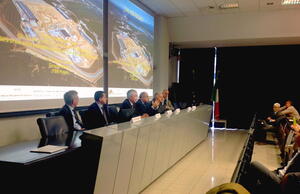A cooperation with Italy's largest engineering school
With an enrollment of close to 40,000 students, Politecnico di Milano is the largest technical university and engineering school in Italy.
The Politecnico designed and operated the country's first nuclear research reactor in the late 1950s and has since accumulated a large expertise in nuclear-related technologies.
A recently built, state-of-the-art laboratory will enable Politecnico scientists and students to access the most technologically advanced equipment. And this of course, is of interest to ITER...
On 21 January the Rector of Politecnico di Milano, Giovanni Azzone, and the Director-General of the ITER Organization, Osamu Motojima, signed a Memorandum of Understanding to promote cooperation and exchange between the two institutions.
Potential areas of collaboration include the joint supervision of MsC or PhD theses; joint training and collaboration of young scientists and engineers; the exchange of technical and scientific data; joint research projects, particularly in the field of cryogenics, and electrical and nuclear engineering.
"It is a great opportunity for both our institutions," says the head of the ITER Central Engineering and Plant Directorate Sergio Orlandi. "What is at stake, beyond the technical and scientific cooperation aspects, is the creation of a new, strong generation for fusion."
In the field of cryogenics, for instance, cooperation with Politecnico di Milano should be extremely fruitful. "Cryogenics knowledge is not generated by universities," stresses Sergio. "When you need experts for ITER, you hire them from CERN, Air Liquide or other private companies... We need to develop academic studies in cryogenics in order to answer the needs of fusion research and, ultimately, industry."


